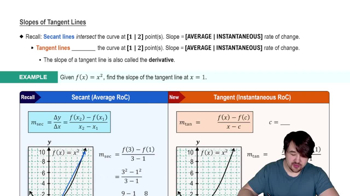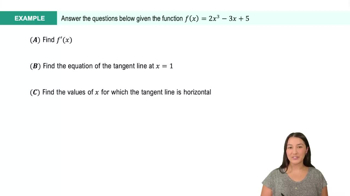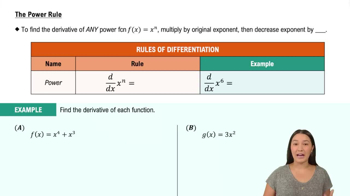Table of contents
- 0. Functions7h 52m
- Introduction to Functions16m
- Piecewise Functions10m
- Properties of Functions9m
- Common Functions1h 8m
- Transformations5m
- Combining Functions27m
- Exponent rules32m
- Exponential Functions28m
- Logarithmic Functions24m
- Properties of Logarithms34m
- Exponential & Logarithmic Equations35m
- Introduction to Trigonometric Functions38m
- Graphs of Trigonometric Functions44m
- Trigonometric Identities47m
- Inverse Trigonometric Functions48m
- 1. Limits and Continuity2h 2m
- 2. Intro to Derivatives1h 33m
- 3. Techniques of Differentiation3h 18m
- 4. Applications of Derivatives2h 38m
- 5. Graphical Applications of Derivatives6h 2m
- 6. Derivatives of Inverse, Exponential, & Logarithmic Functions2h 37m
- 7. Antiderivatives & Indefinite Integrals1h 26m
- 8. Definite Integrals4h 44m
- 9. Graphical Applications of Integrals2h 27m
- 10. Physics Applications of Integrals 2h 22m
3. Techniques of Differentiation
Basic Rules of Differentiation
Problem 74a
Textbook Question
Suppose f(3) = 1 and f′(3) = 4. Let g(x) = x2 + f(x) and h(x) = 3f(x).
Find an equation of the line tangent to y = g(x) at x = 3.
 Verified step by step guidance
Verified step by step guidance1
Step 1: Identify the function g(x) and its components. We have g(x) = x^2 + f(x).
Step 2: To find the equation of the tangent line, we need the slope at x = 3. This requires finding g'(x), the derivative of g(x).
Step 3: Differentiate g(x) = x^2 + f(x) to get g'(x) = 2x + f'(x).
Step 4: Substitute x = 3 into g'(x) to find the slope of the tangent line: g'(3) = 2(3) + f'(3).
Step 5: Use the point-slope form of a line, y - y_1 = m(x - x_1), where m is the slope from Step 4, and (x_1, y_1) is the point (3, g(3)). Calculate g(3) using g(3) = 3^2 + f(3).
 Verified video answer for a similar problem:
Verified video answer for a similar problem:This video solution was recommended by our tutors as helpful for the problem above
Video duration:
6mPlay a video:
Was this helpful?
Key Concepts
Here are the essential concepts you must grasp in order to answer the question correctly.
Tangent Line
A tangent line to a curve at a given point is a straight line that touches the curve at that point without crossing it. The slope of the tangent line is given by the derivative of the function at that point. For a function g(x), the equation of the tangent line at x = a can be expressed as y = g(a) + g'(a)(x - a).
Recommended video:

Slopes of Tangent Lines
Derivative
The derivative of a function measures how the function's output changes as its input changes. It is defined as the limit of the average rate of change of the function as the interval approaches zero. In this context, f'(3) = 4 indicates that at x = 3, the function f is increasing at a rate of 4 units of output for every 1 unit of input.
Recommended video:

Derivatives
Function Composition
Function composition involves combining two functions to create a new function. In this case, g(x) = x² + f(x) combines the polynomial function x² with the function f(x). Understanding how to differentiate composite functions is essential for finding the derivative g'(x), which is necessary for determining the slope of the tangent line.
Recommended video:

Evaluate Composite Functions - Special Cases

 3:59m
3:59mWatch next
Master Derivatives of Linear Functions with a bite sized video explanation from Callie
Start learningRelated Videos
Related Practice







